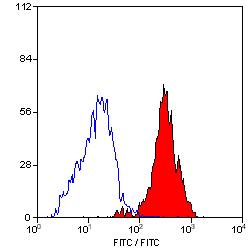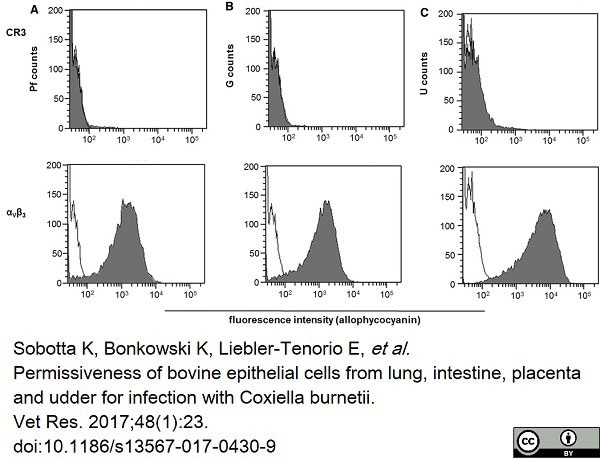CD61 antibody | JM2E5


Mouse anti Pig CD61
- Product Type
- Monoclonal Antibody
- Clone
- JM2E5
- Isotype
- IgG1
- Specificity
- CD61
| Mouse anti Pig CD61 antibody, clone JM2E5 recognizes the porcine CD61 cell surface antigen, also known as platelet glycoprotein IIIa or integrin beta. CD61 is present on the megakaryocyte/platelet lineage, granulocytes, cells from the monocyte/macrophage lineage and endothelial cells (Moreno et al. 2002). CD61 is also broadly expressed on tissues, such as epithelial cells from tubules in the kidney (Piriou-Guzylack et al., 2008), spleen, intestinal mucosa and Leydig cells in testis (Moreno et al. 2002). Mouse anti Pig CD61 antibody, clone JM2E5 detects a band of approximately 85 kDa in porcine platelet lysates by western blotting. The epitope recognized by this antibody is not sensitive to EDTA. |
- Target Species
- Pig
- Species Cross-Reactivity
-
Target Species Cross Reactivity Dog Human Bovine Horse - N.B. Antibody reactivity and working conditions may vary between species.
- Product Form
- Purified IgG - liquid
- Preparation
- Purified IgG prepared by affinity chromatography on Protein A from tissue culture supernatant
- Buffer Solution
- Phosphate buffered saline
- Preservative Stabilisers
- 0.09% sodium azide (NaN3)
- Carrier Free
- Yes
- Immunogen
- Porcine peripheral blood mononuclear cells.
- Approx. Protein Concentrations
- IgG concentration 1.0 mg/ml
- Fusion Partners
- Spleen cells from immunized Balb/c mice were fused with cells of the mouse SP2/0 - Ag14 myeloma cell line.
- Regulatory
- For research purposes only
- Guarantee
- 12 months from date of despatch
Avoid repeated freezing and thawing as this may denature the antibody. Storage in frost-free freezers is not recommended.
| Application Name | Verified | Min Dilution | Max Dilution |
|---|---|---|---|
| Flow Cytometry | 1/50 | 1/100 | |
| Immunohistology - Frozen | |||
| Immunohistology - Paraffin 1 | |||
| Immunoprecipitation | |||
| Western Blotting |
- 1 This product requires antigen retrieval using heat treatment methods prior to staining of paraffin sections. Sodium citrate buffer pH6.0 is recommended for this purpose.
- Flow Cytometry
- Use 10μl of the suggested working dilution to label 106 cells in 100μl
| Description | Product Code | Applications | Pack Size | List Price | Your Price | Quantity | |
|---|---|---|---|---|---|---|---|
| Mouse IgG1 Negative Control | MCA928 | F | 100 Tests |
|
Log in | ||
| List Price | Your Price | ||||||
|
|
Log in | ||||||
| Description | Mouse IgG1 Negative Control | ||||||
References for CD61 antibody
-
Pérez de la Lastra, J.M. et al. (1997) Characterization of the porcine homologue to human platelet glycoprotein IIb-IIIa (CD41/CD61) by a monoclonal antibody.
Tissue Antigens. 49 (6): 588-94. -
Arce, C et al. (2001) Expression of CD61 (beta 3 integrin subunit) on canine cells.
Platelets 12:69-73. -
Moreno, A. et al. (2002) Immunohistochemical analysis of beta3 integrin (CD61): expression in pig tissues and human tumors.
Histol Histopathol. 17 (2): 347-52. -
Zhang, J.L. et al. (2007) Up-regulated expression of beta3 integrin induced by dengue virus serotype 2 infection associated with virus entry into human dermal microvascular endothelial cells.
Biochem Biophys Res Commun. 356: 763-8. -
Campos, E. et al. (2004) In vitro effect of classical swine fever virus on a porcine aortic endothelial cell line.
Vet Res. 35: 625-33. -
Sobotta, K. et al. (2017) Permissiveness of bovine epithelial cells from lung, intestine, placenta and udder for infection with Coxiella burnetii.
Vet Res. 48 (1): 23. -
Arenal, Á. et al. (2022) Effects of Cardiac Stem Cell on Postinfarction Arrhythmogenic Substrate.
Int J Mol Sci. 23 (24): 16211. -
Batchinsky, A.I. et al. (2023) Intravenous Autologous Bone-Marrow-derived Mesenchymal Stromal Cells Delay Acute Respiratory Distress Syndrome in Swine.
Am J Respir Crit Care Med. Oct 05 [Epub ahead of print].
View The Latest Product References
Further Reading
-
Piriou-Guzylack, L. (2008) Membrane markers of the immune cells in swine: an update.
Vet Res. 39: 54.
- Synonyms
- Integrin Beta 3 Chain
- RRID
- AB_11152935
- UniProt
- Q95JH1
MCA2263GA
If you cannot find the batch/lot you are looking for please contact our technical support team for assistance.
Please Note: All Products are "FOR RESEARCH PURPOSES ONLY"
View all Anti-Pig ProductsAlways be the first to know.
When we launch new products and resources to help you achieve more in the lab.
Yes, sign me up
